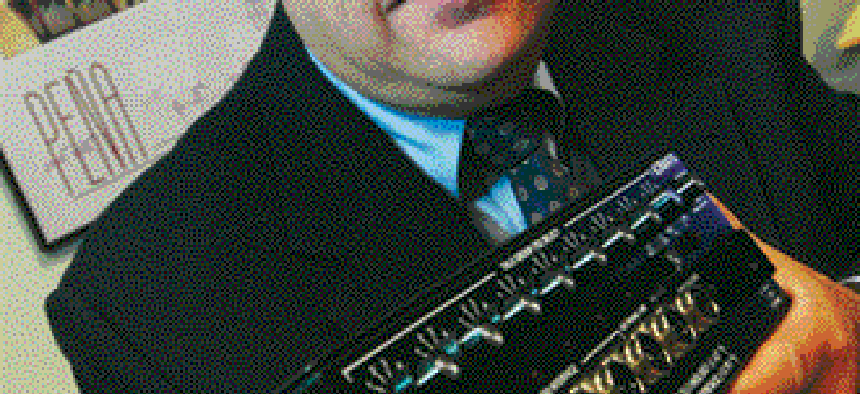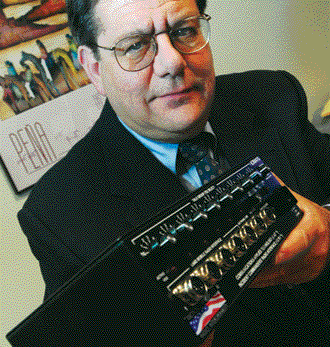Command on the go

With flood waters knocking out power and wind crumpling communication towers, those responding to Hurricane Katrina were effectively silenced. The loss of communications led to a widespread breakdown in the chain of command, and with it any hope of a coordinated, effective response.
With flood waters knocking out power and wind crumpling communication towers, those responding to Hurricane Katrina were effectively silenced. The loss of communications led to a widespread breakdown in the chain of command, and with it any hope of a coordinated, effective response.Although the scenario had been predicted for some time, local, state and federal officials were caught unprepared as the devastation was unleashed on the Gulf Coast.A congressional investigation on the response criticized the Federal Emergency Management Agency for not pre-positioning mobile communications in New Orleans to meet the impending need. The lack of communication resulted in "poor situational awareness," and negatively affected command and control, the investigation found.Even if communications had been restored quickly, lingering interoperability issues among federal, state and local officials would have complicated relief efforts.With the problems identified, and a clear goal set to give first responders a militarylike, common operational picture, the opportunities for technology companies to provide better disaster-response communication systems looks bright, experts said.Communications-Applied Technology Inc.'s radio interoperable device, the Incident Commander's Radio Interface, is designed to bridge communications among first responders, said Seth Leyman, president and founder of the Reston, Va., company.Developed to operate in a tactical military environment, the radio interface creates a bridge between different devices, such as analog two-way radio, digital two-way radios and cell phones.To operate, plug one of each type of radio, such as a city police force's digital radio and a National Guard unit's VHF radio, into the boxlike device. After the radios are connected, an onsite incident commander can designate a specific channel for interoperability and leave the remaining channels open for communication by individual groups."You don't want to just throw everybody onto a common box, because you have a potential situation where everybody is trying to talk about things that don't necessarily need to be shared," Leyman said. "Just because you can connect radios doesn't mean you want to connect all of them."First responders like the device's ability to connect dissimilar devices easily, he said."They can connect very quickly to a cell phone or landline," Leyman said. "If they need to talk to someone at the Environmental Protection Agency or the Centers for Disease Control who may not be carrying a radio, they can reach him by phone."The ability to use different communication systems is critical in a disaster as widespread as Hurricane Katrina.The Louisiana State Police, for example, operate a statewide analog system used by 70 agencies with more than 10,000 subscribers.The storm damage was severe and debilitating statewide. The system's 46 towers depend on electricity, and when that was lost, keeping emergency generators running was hampered by debris and flood waters.Technology companies need to bring a new way of thinking when designing solutions to avoid such breakdowns, said Morgan Wright of Cisco Systems Inc. Wright is working on the company's Solutions With Advanced Technologies program, an approach to public safety networking that unifies the chain of command with voice, video, data and mobility.Rather than considering the problem horizontally, such as fixing one problem at a time, companies should approach the issue vertically and design solutions that address all the tasks of first responders and make those solutions flexible and redundant.The five tasks, or layers, of public safety that need to be connected are main headquarters, field headquarters, emergency operation centers that receive 911 calls, mobile command centers and field personnel. Solutions have been developed to fix deficiencies within each individual layer, Wright said."What we need to do is turn this 90 degrees, and unify the entire chain of command on a standards-based, off-the-shelf platform, a system they can build on instead of trying to build solutions at each horizontal layer," Wright said.Each layer may have different needs, but sharing all information by unifying the entire chain of command gives the system greater flexibility. If a hurricane knocks out one layer, the other layers can take over those functions."We're demonstrating a real field-based implementation of a mobile command vehicle working as a forward-operating center. It is basically a functioning field headquarters," Wright said. "We have the capability to take inbound 911 calls, so we can set up and take calls from anywhere that we can reach a network. We're no longer confined to fixed infrastructure."Katrina demonstrated the pitfalls of depending on fixed locations for communications and command and control. When a location went down, often a neighboring county was the backup.The problem with that plan was that Katrina took out both counties."We no longer want to be geographically limited to where backups are. We want to be able to build a 911 network anywhere," Wright said. "With an IP system, we can handle inbound calls anywhere."Wolf Coach Inc., a subsidiary of L-3 Communications Inc., demonstrated the power of an IP-based mobile unit during Katrina, said founder Richard Wolf.He received a phone call from Entergy Inc., the parent company of one of the Gulf Coast's nuclear power plants. Entergy officials knew their power plant was offline but couldn't communicate with it. They wanted a small sport utility vehicle that Wolf Coach configured for a satellite connection and an IP phone system."The Entergy drivers disappeared with the vehicle the next morning and, as near as I can tell, that was their phone circuit for a few days," Wolf said.As soon as the vehicle arrived on site, it automatically acquired the satellite, "and got the dial tone from North Carolina. It gave them four phone lines for days," he said.Wolf also drove to the Gulf Coast with a larger command center vehicle, which ended up acting as the Red Cross' Bayou district office for more than two weeks, he said.Government officials have taken notice of mobile IP phone systems.The Defense Department awarded L-3 a contract for 19 MC2 sport utility vehicle-based mobile command centers and two large Sentinel custom body-on-chassis mobile communication centers to support homeland security efforts.The mobile communications centers are IP network-centric systems that converge voice, data and image traffic to let responders send e-mail, manage data and make IP phone calls.The vehicle not only helped keep officials connected, it also demonstrated the importance of having a variety of communication methods. With landlines and cell phones not working, radio frequencies quickly became jammed with traffic in New Orleans. Introducing IP phones helped alleviate that jam."If we can strip off the radio traffic of those things that don't have to be done by radio, it frees up the radio frequency significantly to handle the more critical information flow," Wolf said.Staff Writer Doug Beizer can be reached at dbeizer@postnewsweektech.com.

Ready and waiting
IP to the rescue

"You don't want to just throw everybody onto a common box, because you have a potential situation where everybody is trying to talk about things that don't necessarily need to be shared," says Seth Leyman Communications-Applied Technology Inc.'s president and founder.
Rick Steele
Ready and waiting
IP to the rescue
NEXT STORY: Katrina forces rethinking

